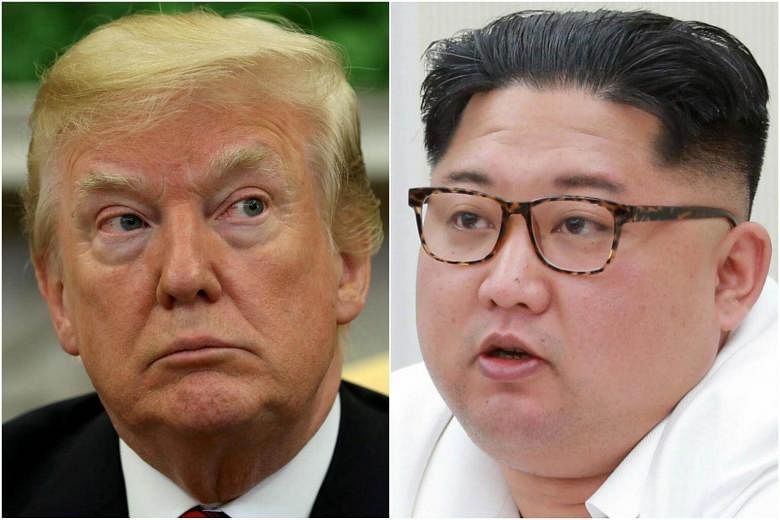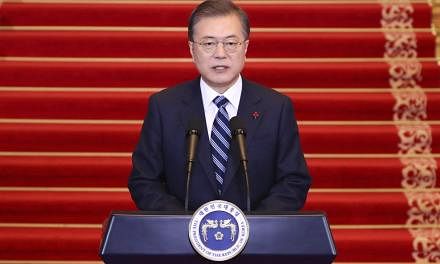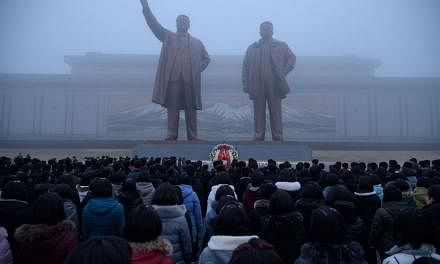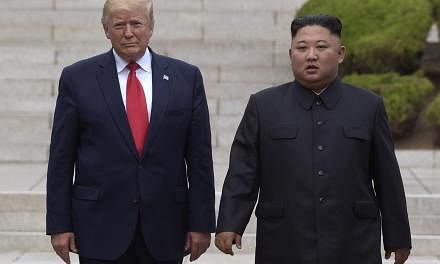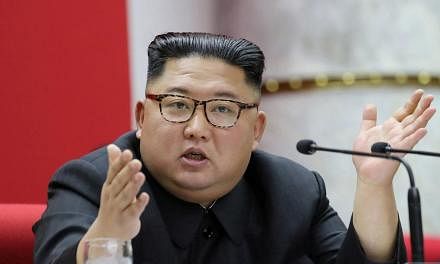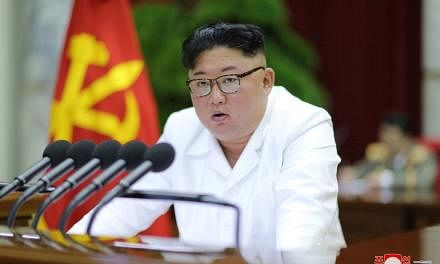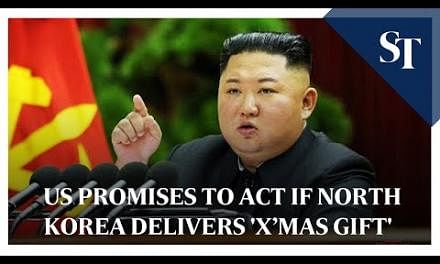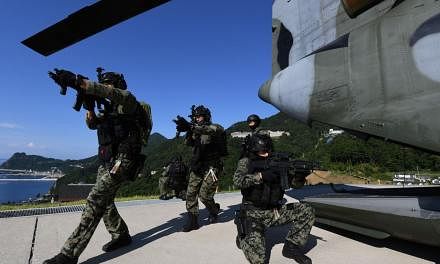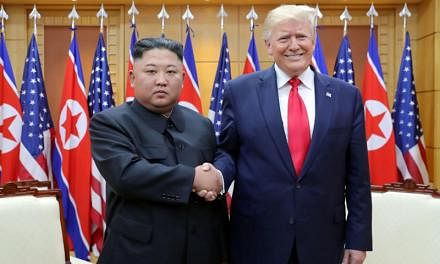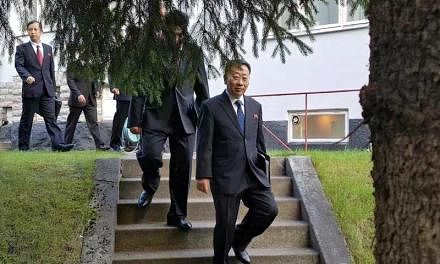Amid the hype over the on-off-on-again North Korea-United States summit, it is worth reminding ourselves that, in a sense, we have been here before.
A similarly "historic" deal was struck between Washington and Pyongyang in 1994. Then, under what was dubbed the "Agreed Framework", North Korean leader Kim Jong Un's grandfather, Mr Kim Il Sung, pledged to dismantle his country's nuclear programme.
In return, he demanded fuel to make up for the loss of nuclear power. He also sought some light-water reactors as alternatives to the plutonium reactors being destroyed which addressed the world's concerns about the proliferation of nuclear weapons.
"Neither side fully delivered on these promises. President Bill Clinton could not persuade Congress to fully fund the fuel oil programme or get Japan and South Korea to provide the new reactors. North Korea, for its part, began a clandestine nuclear-enrichment programme," notes Mr James Dobbins, senior fellow at Rand Corporation and a former assistant US secretary of state, writing in the American political website The Hill.
When the North Korean cheating was discovered, about a decade later, President George W. Bush chose to walk away from this agreement. And so followed a "cycle of agreement and flawed follow-through" - including the later Six-Party Talks, which kicked off in 2003 and also ended in grief, thereby adding to the sense of distrust between the two countries.
Given this backdrop, Mr Dobbins concludes, somewhat ominously: "Any agreement between Trump and Kim would, at best, only be the opening of a multi-year process of denuclearisation and reciprocal economic benefits, a process that has already failed twice for lack of follow-through."
So are we heading back to the future with this latest round of talks? Or are the stars now somehow aligned for a significant breakthrough in the long-fraught relations between the two countries?
Does the meeting in Singapore say more about the vanity of the two protagonists, eager to strut for a brief historic moment on the global stage, or does it signal a genuine victory for peace on the Korean peninsula, with a much belated declaration of an end to hostilities, six decades after the end of the war in 1953 that split Korea into two agonising halves along the 38th parallel?
Indeed, both leaders are heading to Singapore seemingly eager for a deal, not least because of their respective economic and political problems at home.
Amid the mounting investigation into his team's dealings with Russia during his election campaign, and much acrimony at the Group of Seven (G-7) meeting in Canada, Mr Donald Trump could do with a major foreign policy win.
Besides, by his own admission, he "likes making deals", especially big ones, and even better if they draw the attention of members of the Nobel Prize committee in Stockholm.
"Deals are my art form," he said in his 1987 book, The Art Of The Deal. "Other people paint beautifully on canvas or write wonderful poetry. I like making deals. Preferably big deals. That's how I get my kicks.
"Most people are surprised by the way I work. I play it very loose. I don't carry a briefcase. I try not to schedule too many meetings. I leave my door open."
Also keeping the door open is Mr Kim, whose regime is reeling from the impact of tough economic sanctions imposed on his country. He, too, would rather fancy being recognised on the world stage, as an equal to the US, no less.
Since taking over from his father, he has pursued a twin-track policy of pushing simultaneously for nuclear weapons and economic growth, with a view to building a "great socialist nuclear power".
But just days before his summit meeting with his South Korean counterpart, Mr Moon Jae In, in April, the Chairman of the State Affairs Commission, as he is officially called, ditched this signature programme, known as byungjin, or "parallel advance".
The byungjin policy had achieved a "great victory", namely an arsenal capable of deterring the country's foes, he insisted. So, it was time to adopt a "new strategic line", to focus the country's resources on boosting its economy.

Under this new policy, Mr Kim set five-year production targets that might make the "sounds of the people's joyful laughter ring out far and wide". Over the longer term, the economy would seek to provide "all the people with an abundant and developed life with nothing to envy".
Against this backdrop of an apparent shift in Pyongyang's thinking, the world watched with a mix of delight and relief as the two Korean leaders met and embraced like long-lost brothers at their bilateral summit in April.
They went so far as to announce plans to gradually reduce weapons on both sides. They pledged to seek meetings with the US and China to declare the official end of the 1950-1953 Korean War and replace the armistice with a peace treaty.
"We solemnly declare to our 80 million people and the world that there will be no more war on the Korean peninsula and a new era of peace has begun," they said in a joint statement. "It is our urgent historic assignment to put an end to this current abnormal state of ceasefire and establish a peace regime," they added.
So, long after the horrific war that some estimates say wiped out 20 per cent of the population on the Korean peninsula, the idea that a formal declaration of peace - but not quite a full peace treaty, which entails recognising North Korea's sovereignty and the formal division of the peninsula into two states - might be within reach has gained traction.
Signalling as much after meeting the North Korean leader's right-hand man, Mr Kim Yong Chol, in Washington recently, Mr Trump said: "We talked about ending the war... And there is a possibility of something like that. That's more of a signing of a document that it's very important in one way. Historically, it's very important. But we'll see."
Excited by this prospect, President Moon tossed up the possibility of flying to Singapore too in order to follow up with a trilateral meeting the day after Mr Trump and Mr Kim meet here, if their discussions go well.
Much as host country Singapore will go all out to try to ensure the summit runs smoothly, whether the talks are a success will depend on the two key players in the meeting room at the Capella Singapore hotel on Sentosa. Significant differences remain though, not least since both sides have vastly different ideas about what nuclear disarmament of the Korean peninsula might mean, and how to go about achieving it.
Some of the more hawkish elements in the Trump administration - notably National Security Adviser John Bolton and Ms Susan Thornton, the State Department's acting ambassador for East Asia and Pacific affairs - have insisted that the US seek a deal that sees a rapid move by the North Koreans to discard their nuclear weapons, or at least a clear timeline in which Pyongyang would do so.
Speaking in Singapore at the recent Shangri-La Dialogue, US Defence Secretary James Mattis also made plain that Washington would not budge from its "maximum pressure" approach of economic penalties on North Korea until the country showed its commitment to denuclearising the Korean peninsula.
"We must remain vigilant, and we will continue to implement all UN Security Council resolutions on North Korea," he said. "North Korea will receive relief only when it demonstrates verifiable and irreversible steps to denuclearisation."
Mr Kim, who has likened his nuclear weapons to a "powerful treasured sword for defending peace", however, favours a more gradualist approach, with a phased tit-for-tat exchange of economic benefits and security guarantees, before he parts with any of his nuclear weapons.
Most of all, he will want to secure assurances from the US about the future of his regime and that there will be no repeat of the so-called "Libyan experience". New York Times correspondent David Sanger summed this up starkly in a recent report: "The Libya intervention allowed anti-government rebels to put Colonel Gaddafi on the run, and months later they pulled him from a ditch and killed him. Since then, Libya has devolved into a dysfunctional state. And North Korea has taken notice."
Perhaps recognising this, US Secretary of State Mike Pompeo, who met Mr Kim twice in recent months, has offered security assurances and American investment as an incentive.

"Those are the kind of things that, if we get what it is the President has demanded - the complete, verifiable, irreversible denuclearisation (CVID) of North Korea - that the American people will offer in spades," he said.
Keeping the door open - and giving himself some wiggle room - Mr Trump has also begun saying in recent days that dealing with North Korea would be a "process", more a marathon of prolonged engagement rather than a quick dash to a deal in one day.
"They want it. We think it's important. I think we would be making a big mistake if we didn't have it," he said of the upcoming summit, adding: "I think we're going to have a relationship and it will start on June 12."
That would be a welcome start, but given the deep distrust on both sides, many political analysts will be watching with a mix of hope and scepticism.
So, too, will leaders in China, Japan and Russia, who despite having urged the US to talk directly with the North Koreans for years, are now ironically anxious not to be sidelined and eager to have a hand in shaping any deal that might arise.
So while the broad outline of what a possible declaration for peace and disarmament - with quid pro quos of security assurances and economic support in exchange - might seem clear, getting both sides to a point where they are confident enough to put their signatures to it will, by no means, be easy to swing.
And, more importantly, while any agreement reached need not be overly long and complex - the 1994 Agreed Framework ran to only a few pages - implementing it could take years of sustained effort and continuing goodwill.
Summing this up well, Mr Mark Fitzpatrick, executive director of the International Institute of Strategic Studies - Americas and a former diplomat specialising in nuclear non-proliferation, put it this way in an interview with The Straits Times: "When North Korea agreed at the Panmunjom summit on the goal of complete denuclearisation, it was an aspiration...
"It is quite possible that while retaining the goal of CVID, the United States could agree to a step-by-step movement towards it that would involve some early dismantlement by North Korea, and the US making some concessions," he said. "That is probably the only feasible way."
So, will the events over the next few days be just a matter of vanity, with all the sound and flurry of handshakes and photographs ultimately being of little lasting significance?
Or might Sentosa live up to what it means in Malay - peace and tranquillity - to be the unlikely scene of an unexpected victory for all those who have yearned for decades for an end to senseless but lingering regional hostilities?
Much depends on whether Mr Trump and Mr Kim are able to seal a deal in Singapore. And whether their two countries move forward to deliver on this to prevent a repeat of the cycle of grand agreements that flounder and fail for lack of follow-through.
Which will it be? Well, as Mr Trump is wont to say: "We'll see."
@theSTeditor


